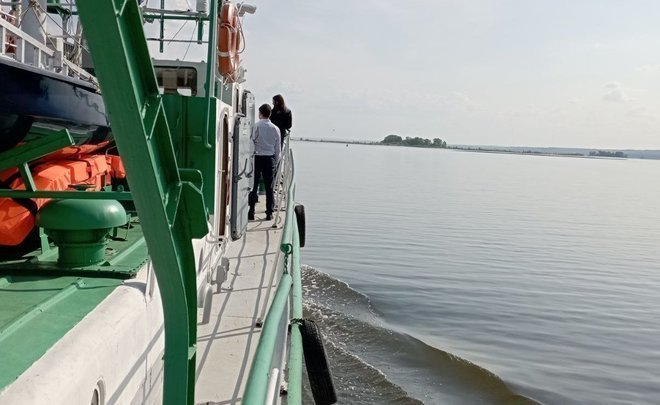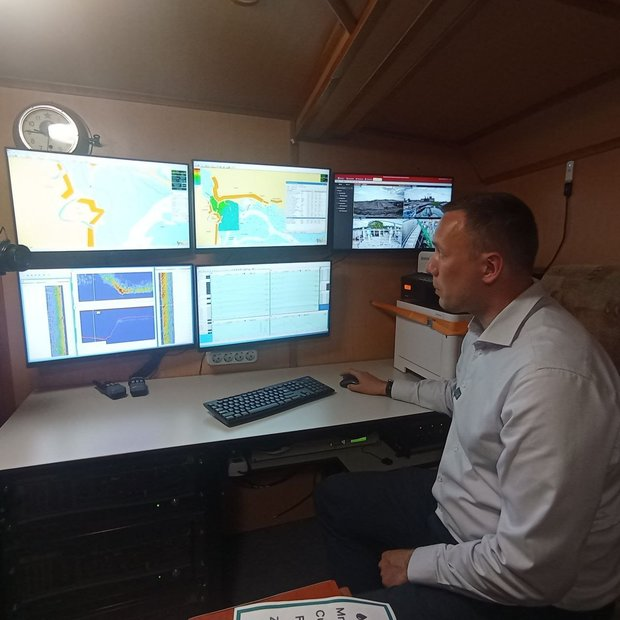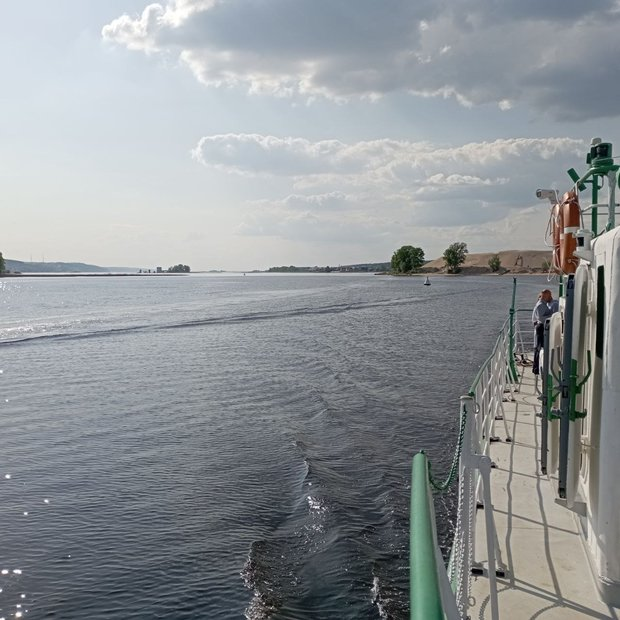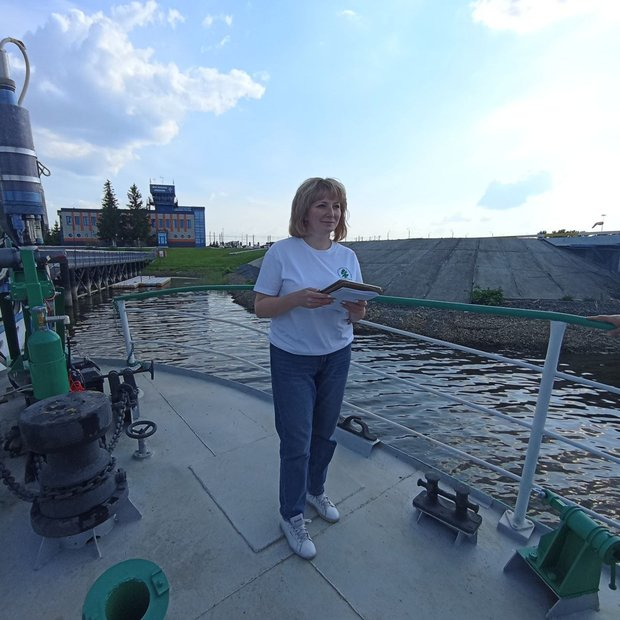Any flamingos in Tatarstan?
How the republic’s ecologists’ research ship — the most elaborate one in Russia — works

Tatarstan ecologists have a unique ship — Flamingo research ship — at their disposal. It looks like an ordinary ship, not the newest (built in 1991), nevertheless, today it is the most potent floating laboratory in Russia, as the engineers of its “filling” claim. It recently operated its first trip after new total renovation of its software and laboratory equipment. Realnoe Vremya’s correspondent saw Flamingo and asked ecologists about how it worked.
What Flamingo hunts for
Flamingo research patrol ship built in 1991 was given to the Tatarstan Ministry of Environment and Natural Resources in 1996. As Olga Manidicheva, vice minister of environment and natural resources of Tatarstan, said, it was one of the first ships in Russia that could do large-scale water, physical and chemical research on big water sites. Its tasks have been to research and monitor the Kuybyshev and Nizhnekamsk water reservoirs.
The point of Flamingo’s work is to cruise in water, take samples non-stop, analyse them on the spot (the ship is equipped with an automated chemical lab for this), do graphics and create maps (the ship’s software and equipment allows doing all this). So a dynamic big picture of the state of the water is created in real time right on the spot. This is at times especially important to control the quality of water in discharge areas of treatment facilities; where cross-border water mass transfer; in places where big rivers meet; during accidents in water; to stop illegal production of natural resources in water facilities. In a word, quick but as complete as possible analysis of the situation is needed everywhere when non-stop water control is required.

Olga Manidicheva, vice minister of environment and natural resources of Tatarstan, explains:
“Monitoring the quality of water facilities is especially important in the light of those projects that are implemented today within Environment national project: large-scale modernisation of treatment facilities, Volga River Rehabilitation projects and other big undertakings related to the control of water. Flamingo allows both detecting deep sewage discharge areas and analyse their quality. Video cameras can register violations in motion. Hydrochemical and hydrophysical indicator readings are taken in real time making maps and analysing them at a computer centre later. All this allows making management decisions quickly to improve the quality of water facilities in our republic.”
28 million for upgrade
The ship was thoroughly modernised twice — in 2007 and 2022. The latest upgrade cost 28 million rubles (funded by the republic’s budget): 10 million was spent to renovate the ship itself, 18 million was to upgrade the equipment.
NAEKO group of companies (Saint Petersburg) that has been creating environment protecting ships and environment quality control systems since 1967 designed Flamingo research ship. The company’s representative Alexey Bulygin claims that all elements of the system — the software, measuring systems, sample taking system — are designed and made in Russia. All means of measurement and devices are added on the state registry and have all necessary certificates.

Alexey Bulygin says the ship is the only in Russia that has such equipment:
“Tatarstan is one of the leaders, it was one of the first to order such a system as early as the 90s. But technologies don’t stay still, this is why it is not enough to order such equipment, it needs to be upgraded. And today we can say that Tatarstan has the most modern, unique and only mobile water laboratory in Russia. Flamingo with its equipment upgraded in 2022 is the most elaborate, exemplary so to speak, ship.”
The engineers say that tens of such complexes have been put into operation since 1990. Now they are used by Kaliningrad, Moscow, Kazan and Irkutsk. There is still a ship in Sevastopol designed for the needs of the Ministry of Defence. Others weren’t modernised on time and gradually were withdrawn from operation. And different regions use the obsolete equipment differently. For instance, the equipment in Astrakhan was transferred to a fixed laboratory and they do analysts of water samples. So there are only five mobile laboratories in Russia nowadays — and the Tatarstan Flamingo has evolved the best.
The complex is divided into three key sectors — a round-trip device, chemical lab and the “brain” of the ship — the computer centre.
Mechanical arm with a variety of fingers
The round-trip device is installed on Flamingo’s prow. It looks like a mechanical arm, however, it has more both joints and fingers than a human arm. Before the ship takes off, the operator removes lids from sensors, presses a lever and the arm turns around, unfolds lowering the arm into up to 130cm deep into the water.
The device has sensors that take hydrophysical water readings and send the information to the command point — the computer centre. Six sensors control the change of the water: temperature, conductivity, eH, pH, dissolved oxygen, hydrostatical pressure and salt content. A turbidity meter is also here: it control water transparency.

Then the arm is installed ultrasound tubes to analyse the water column. They determine water abnormalities, commotion: send rays along the ship and its boards. There is also another channel at the bottom of the ship. So the ultrasound “picture of the world” is shown around Flamingo, except for the stern.
A non-stop sample taking system is one of the fingers of the mechanic arm. It constantly takes water and sends it to the chemical lab: there is a network of pipes made of chemically inert materials along the ship directly to the laboratory. Inertia is one of the key conditions because the sample needs to reach the analyser without changing its chemical composition.
Laboratory sensors can simultaneously analyse eight indicators. The laboratory can analyse water in a total of 15 parameters. A set of six substances is determined by the operator considering tasks and the well-known manmade impact on Tatarstan water ecosystems. Depending on the tasks, the parameters can be changed by removing those the ecologists aren’t interested in here and now and adding those that should be paid attention.
“But if something special happens, for instance, the equipment shows suspicious turbidity, the ship can be stopped, samples can be taken and sent for a more detailed, complete analysis to the lab,” says Olga Manidicheva.
Also, the round-trip device has an oil spill detector. If there is an oil film on the water surface, its sample is taken, the thickness is measures and the covered area is calculated, a map is created. The damage will be assessed on the basis of this data.

Chemical “heart” of the ship
Water is supplied to the chemical lab equipped in the ship through a sample taking network. Samples are first prepared here: water is filtered and mixed with chemical reagents for analysis. After that, the continuous injection analyser automatically determines the amount of chemical elements in water. There is a total of eight analysers. They operate automatically: they measure, send data online to the computer centre non-stop in motion. The data is sent once in three minutes, so there is an uninterrupted schedule with a lot of details.
A chemist’s comfortable workplace is organised in the lab: the chemist controls the operation of devices, tracks the results and makes sure necessary reagents are in the analyser. The ecologists are proud that the laboratory is fully modernised starting from the floor to specialised furniture, not to mention the equipment: the new analysers operate quicker and more accurate and it becomes easier and more convenient for the chemist to work with it.
The data is sent to the computer centre: it is analysed, calculated, mapped there.
“The sense of the whole complex is to detect an abnormality, register it, analyse, create a spatial picture of accumulated elements on the map and send information to riverbank services. For instance, if a discharge of polluting substances in water is detected on the way of Flamingo, the ship will stop and analyse this area. An analyst will see on the screen disturbed water via echo sounding. Readings will be taken to determine the cause of the abnormality because it isn’t always a manmade impact — water parameters can change due to natural processes. All this is carefully analysed and examined. Six screens at the computer centre illustrate what’s happening. So there made a big picture of the state of the water,” says Olga Manidicheva.

Another important moment is that after the samples are analysed, water must be discharged. And the laboratory has a special treatment system removing reagents after the analysts so that clean water is discharged.
The “brain” of Flamingo
The computer centre is an ideological and analytic nucleus of the ship. The engineers of the complex note from the beginning: cybersecurity isn’t strange to Flamingo. All the information collected by the complex has dedicated security classification, this is why there is a special protection system so that nobody can obtain and download it.
There are three computers here, each of them has two monitors. One computer is responsible for video cameras that provide a 360-degree view of the ship and send data to the riverbank centre on the Internet.
Another computer shows ultrasounds. Unlike the previous version of the complex, now it has sensors on the left and right sides of the ship. The signal became more detailed, the view improved significantly. Also, this computer shows data of the weather station installed in the ship: it measures temperature, humidity, precipitation, pressure, speed and wind direction.

Earlier, Flamingo couldn’t track ships crossing the water area. Now such a system is installed in the equipment. It helps to see what ship is passing by, if it is registered in the ship system. Its trajectory is created and if needed Flamingo can follow it for some time to see all parameters of water change under this ship. This is needed to control bilge water and check if the ship doesn’t discharge pollutants into the water. So there is instantaneous documentation and what polluting discharges it makes.
Another area of application of the ship tracking system is related to the suppression of illegal mineral production in water. The Ministry of Environment has data on all licences on such production. For instance, if Flamingo sees there is an unidentified ship in the middle of the water that pans gravel shamelessly without any permit (or with some permit but in another place), everything is recorded — the ship has video cameras. The information is immediately sent to the ministry and watchdog specialists are sent to the scene. A leader of the expedition can create a route on the map — it is seen in the ship captain’s cabin.
Flamingo to operate across the republic
The computer centre allows analysing, create the distribution of dissolved substances, temperature maps and distribution in all changing parameters. Digital archives are created as a result and sent to the riverbank centre through a data communication system.

The ship can operate non-stop for eight hours. Its route depends on the programme of examinations.
“This year the task is to go on several expedition trips. Also, to monitor the points that have been added to the programme since 2014. If some critical situation appears in water, Flamingo will go there too. The ship can be involved in mapping, sample taking, quick communication of information about where the pollutant’s spill is going,” Olga Manidicheva explains.
This year Flamingo can be seen in all big water facilities of Tatarstan: it is certainly the whole basin of the Kuybyshev Water Reservoir — it is planned to cover about 380km. Ecologists examine the Nizhnekamsk Water Reservoir too. Also, the ship will work at some specific points: there is a territorial monitoring system developed by the Institute of Environmental and Nature Use Issues, and it is necessary to track the state of the water in some locations according to it. It is the Kuybyshev Water Reservoir above Zelenodolsk; mouths of the Sviyaga, Kama and Kazanka rivers; Kuybyshev Water Reservoir a kilometre above Kazan’s water intake area and below Kazan; Kyzyl Bayrak and Tetyushi.

So Tatarstan’s ecologists showed us their ship with pride — a unique floating lab that doesn’t have equals in Russia nowadays. In case of an accident, an oil or mazut spill, discharge of toxic substances or another similar situation, Flamingo will come to the rescue. But the ecologists stress that Flamingo is a research ship, its main function is not only supervision but also data collection for a better understanding and complete analysis of the situation in water facilities.